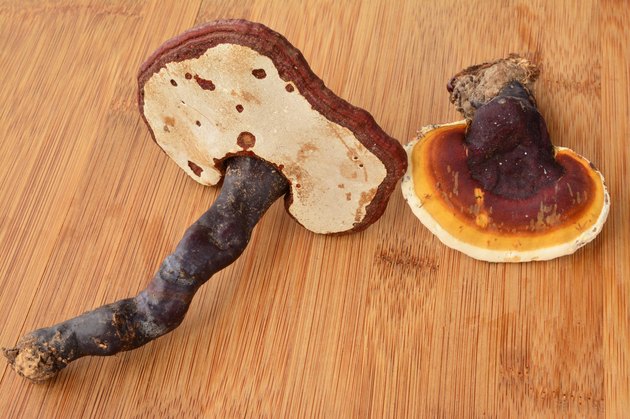
Commonly known as reishi mushroom, Ganoderma lucidum is a purple-brown fungus with a long, thin stalk, spores that are brown in color and a shiny cap shaped like a fan. The mushroom grows on decaying logs and tree stumps. While Ganoderma lucidum is indigenous to North America, Japan and China, it is produced in a number of other Asian countries. The reishi mushroom has many health benefits, but speak with your doctor before taking it.
展示抗癌活动
A study published in the May 2004 issue of "International Journal of Oncology" explored the effects of Ganoderma lucidum on cell growth, cell cycle and cell death in human prostate cancer cells. The results of the study showed that Ganoderma lucidum prevented the multiplication of cancer cells in a dose- and time-dependent manner. The reishi mushroom did so by decreasing the expression of proteins -- cyclin B and Cdc2 -- that allow cancer cells to expand uncontrollably and by increasing the expression of a protein -- p21 -- that suppresses growth of cancer cells. In addition, Ganoderma encouraged death of prostate cancer cells. The study concluded that Ganoderma lucidum may play a role in preventing and treating cancer.
May Help Fight Cancer-Related Fatigue
灵芝可以为癌症相关的疲劳提供缓解,与癌症有关的永无止境的疲倦及其治疗。在2012年“循证互补和替代医学”发表的一项研究中,灵芝的孢子粉在接受内分泌治疗的乳腺癌患有妇女的疲劳方面表现出许可。内分泌治疗是添加,阻断或去除激素来抑制某些癌症的生长,包括乳腺癌的治疗方法。接待灵芝孢子的妇女经历了疲劳和减少焦虑和抑郁症状的改善。
May Help Rheumatoid Arthritis
灵芝的消费可能对类风湿性关节炎具有积极影响,这是一种负面影响关节健康的长期自身免疫性疾病。2007年7月期刊“分子和细胞生物化学”杂志中报道的一项研究研究了灵芝发现的多糖肽对细胞繁殖和生产细胞因子 - 炎症蛋白 - 在类风湿性关节炎滑膜纤维细胞中。这些是有助于类风湿性关节炎的进展的专门细胞,并且根据2006年6月出版的一项研究,可能是启动疾病的原因。研究人员观察到灵芝多糖肽成功抑制了细胞因子和细胞增殖的产生在这些成纤维细胞中。需要进一步研究来研究灵芝的作用机制。
为肝脏提供保护
A study published in the August 2002 issue of "World Journal of Gastroenterology" explored the potential of Ganoderma lucidum polysaccharide, or GLP, to prevent liver damage in mice. To induce liver injury, mice were treated with Mycobacterium bovis bacillus Calmette-Guerin, plus inflammatory cytokines or lipopolysaccharides. Researchers observed increases in liver weight, blood levels of the enzyme alanine aminotransferase, or ALT, and nitric oxide production. Increased levels of ALT and nitric oxide indicate liver damage. Treatment of mice with GLP significantly reduced liver weight and ALT levels. Furthermore, there was a marked decline in nitric oxide production. The study concluded that the liver-protective effects of GLP may be due to its influence on nitric oxide production.
- Drugs.com: Reishi Mushroom
- International Journal of Oncology: Ganoderma Lucidum Inhibits Proliferation and Induces Apoptosis in Human Prostate Cancer Cells PC-3
- National Cancer Institute: Apoptosis
- Clinical Cancer Research: Clinical Significance of Cyclin B1 Protein Expression in Squamous Cell Carcinoma of the Tongue1
- 抗癌研究:P21(WAF1 / CIP1)水平的上调导致前列腺癌细胞系的生长抑制
- 基于证据的互补和替代药物:Ganoderma Lucidum的孢子粉改善了乳腺癌患者接受内分泌治疗的癌症患者:试验临床试验
- Medical College of Wisconsin: # 173 Cancer Related Fatigue
- 国家癌症研究所:内分泌治疗
- Molecular and Cellular Biochemistry: Ganoderma Lucidum Polysaccharide Peptide Reduced the Production of Proinflammatory Cytokines in Activated Rheumatoid Synovial Fibroblast
- Rheumatology: Synovial Fibroblasts: Key Players in Rheumatoid Arthritis
- World Journal of Gastroenterology: Hepatoprotective Role of Ganoderma Lucidum Polysaccharide Against BCG-Induced Immune Liver Injury in Mice
- MedlinePlus: ALT